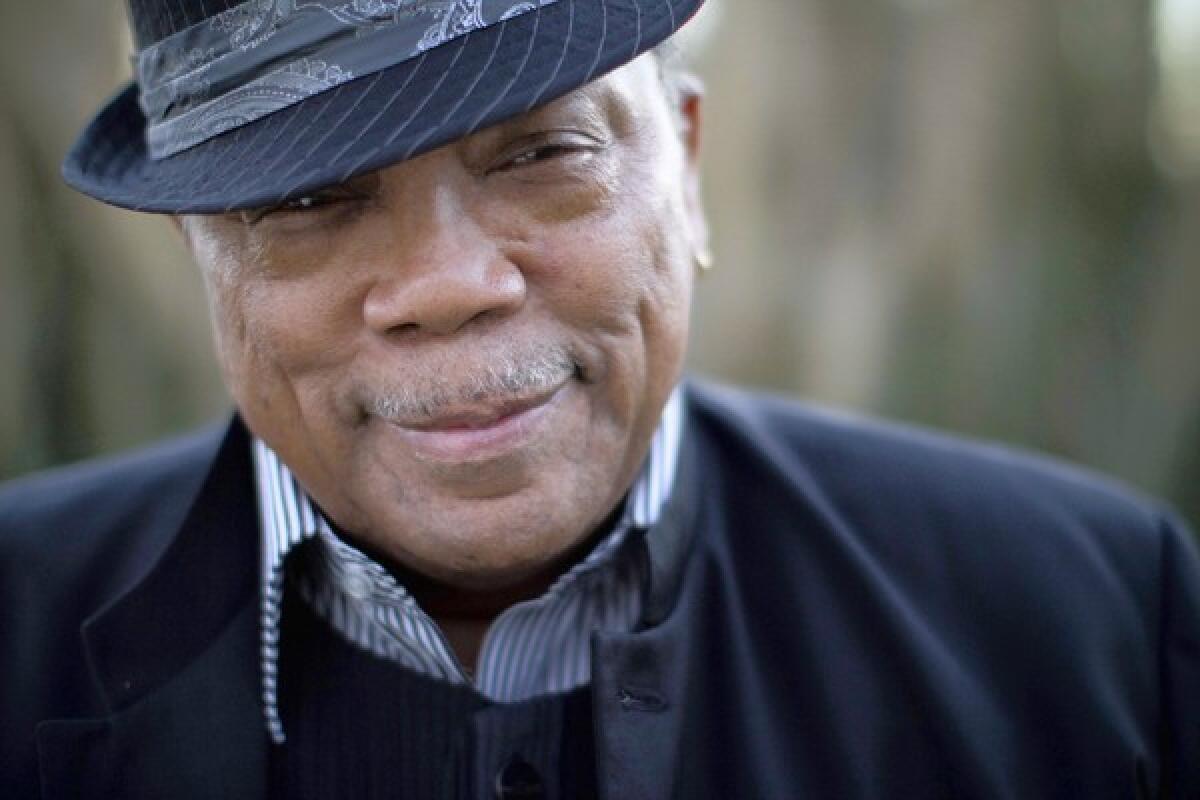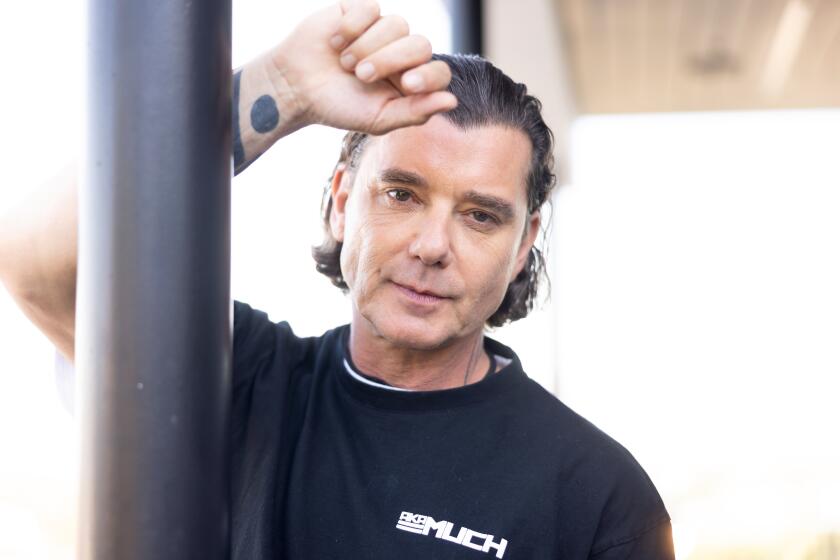Quincy Jones’ long and restless song

- Share via
It had been a long night — a concert, a reunion with an old friend, a midnight meal — but as the clock ticked past 2 a.m. Quincy Jones sat in a rare state of silence in his estate at the very top of Bel-Air. The man they call Q nodded at the cellphone sitting on the kitchen counter.
“I’ve deleted 188 names this year — all the people who died, all these friends of mine,” Jones said. “That’s what happens when you’re 77, man. That’s life, man. You start out playing in bands and doing duets and then you worry that in the end it’s all going to be a solo.”
The song of Q’s life began on the South Side of Chicago. It was March 1933 when a new president named Roosevelt told the American people that the only thing they needed to fear was fear itself. Ten days later, Quincy Delight Jones Jr. was born as part of a staggering boom-time in the nursery of modern music: Elvis Presley, Ray Charles, James Brown, Johnny Cash, Leonard Cohen, Jerry Lee Lewis, Nina Simone, Willie Nelson, Sam Cooke and Jackie Wilson were also born in that golden window between September 1930 and September 1935.
Most of those peers are gone now, but Jones remains a man in relentless motion. He has a new tribute album, a recently published book and a schedule dense with award shows, fundraisers and jet-set parties. Still, he feels the weight of the years and he also thinks quite a bit about legacy maintenance.
“We all wonder how we will be remembered,” says Jones, who rarely gets through any conversation without mentioning the famous friends and sparkling moments of the past. His friendship with the late Charles, especially, tugs at his memory, but instead of maudlin repetition a conversation with Jones is like talking to a jukebox loaded with platinum singles. He’s just playing the old hits so new generations can learn the beat.
“You can’t know the present or the future without knowing the past, and for young black Americans especially, it’s a sin to forget where we’ve been and what we’ve done in music,” Jones said. “The history is who we are. Without it we’re in trouble. We need to teach music history the same way we teach science history.”
Elementary school
A few weeks ago, Jones — resplendent with a shiny, blue pinstripe suit that could have been worn in a “Guys and Dolls” production and a striped scarf that reached his knees — trekked down to East 33rd Street. The Los Angeles Unified School District had invited him to cut the ribbon on Quincy Jones Elementary, which sits less than a mile from the old Dunbar Hotel, the hub of the Central Avenue jazz scene and the place where Duke and Dizzy and Basie and Billie all played.
Jones gigged at the Dunbar too (“I didn’t know where Sunset Boulevard was when I moved to L.A., but sure I knew Central”), but he tried not to talk about all those old ghosts too much as he looked out on a schoolyard of young faces. “When I was growing up as a poor kid in a crime-ridden neighborhood in Chicago, I could not have imagined that I would stand here with you today and witness the dedication of a school with my name on it,” Jones said. “This is one of the greatest honors of my life.”
Jones found his path to fame in Seattle where, as a youngster playing trumpet, he found Charles and the defining friendship of his life. His career seemed kissed by fate. Count Basie became a mentor, and Lionel Hampton invited him to bring his trumpet on tour. He became a coveted arranger and wrote charts for Ellington, Tommy Dorsey and others. One day the phone rang and it was Frank Sinatra, and Jones knew he had reached the summit. “When you get to work with Sinatra, well, that’s the best there is.”
Jones has won 27 Grammys, more than any other living person, but he’s prouder in some ways that he was named vice president of Mercury Records in 1962, breaking the color barrier as far as top-level music executives at major labels. Today, he’s just a few notches below Oprah Winfrey as cosmic-level macher for black America — instead of arranging musical notes he now arranges careers and seeks to compose history.
It’s telling that on his first visit to Southern California as a presidential hopeful, Illinois politician Barack Obama ended up in Jones’ living room listening to war stories about Cairo concerts with Dizzy Gillespie or the view from the soundboard on the night “We Are the World” was recorded in 1985.
As the producer of Michael Jackson’s three signature albums — “Off the Wall,” “Thriller” and “Bad” — Jones created a sonic template for pop that can still be heard in the music of Usher, Justin Timberlake and dozens of other stars. “I watch what Quincy Jones has done, and that’s the guy I want to be,” says will.i.am, leader of the Black Eyed Peas and a Grammy-nominated producer himself. “He is the man.”
Not everyone appreciates Jones and his lord-of-the-manor mien. There’s been a public firefight in recent weeks between Jones and Teddy Riley, the driving force behind “Michael,” a posthumous release constructed from the King of Pop’s studio leftovers and plenty of digital spackle. Jones spoke out against the project and Riley sneered during an interview with the Guardian of London: “Look at his age. He can barely hear you talk.”
There were grumbles too that Jones sounded haughty in US magazine when he dismissed any notion of comparing himself with Kanye West, the brash rapper and producer. “Did [West] write for a symphony orchestra? Does he write for a jazz orchestra? Come on, man.... I’m not putting him down or making a judgment or anything, but we come from two different sides of the planet.”
All-star tribute
Still, most young stars gravitate toward Jones like he is Buddha with a backbeat. In November, looking satisfied behind sunglasses, Jones appeared on the cover of an all-star album: “Q: Soul Bossa Nostra.” The title is a winking reference to Jones’ 1962 instrumental “Soul Bossa Nova” while the Nostra gag nods to his godfather stature.
The album was the brainchild of Timbaland who, almost six years ago, came to Jones with the idea of an urban all-star album built around the Jones discography. After plenty of delays, the album, with contributions by John Legend, Snoop Dogg, Jamie Foxx and Mary J. Blige, was greeted with mixed reviews.
Jones, no surprise, adores the album. “It blew my mind what these artists came up with. It took a long time to get it done with everybody’s schedules, but everyone really gave it up. It’s a special thing.”
He was especially intrigued by Amy Winehouse, the British soul singer who teamed with producer Mark Ronson on a version of “It’s My Party,” the pouty 1963 Lesley Gore single that became the first No.1 hit produced by Jones. The Winehouse version sounds like a karaoke preamble to a bar fight, but it does represent the troubled singer’s first released recording since 2007. When Winehouse was introduced to Jones, she nervously bowed in silence. The admiration goes both ways.
“What a talent, but when I see her what crosses my mind is all the artists I’ve seen who fight with the drugs, you know? Charlie Parker and Ray and Miles Davis and so many guys. The best guys. They say it’s fame, but I think it’s the artist and the artist soul.”
Jones has seven children, and six of them are daughters — a fact, he said, that explains the dents in his head. He has been divorced three times — his marriage to actress Peggy Lipton was the longest, at 16 years — and romantically linked to plenty of famous faces ( Nastassja Kinski had his daughter in 1993).
His children, grandchildren and his own legacy are paramount pursuits now, and his new book, “Q: On Producing,” is the latest exercise in staking out his spot in history.
Sitting in a warm-glow foyer designed to look like a French bistro, Jones was asked about the biggest pivot point moment in his life. He tapped his head where two metal clips are part of the architecture. Surgeons put them in place in 1974 after a brain aneurysm put Jones at death’s door.
Friends gathered around his hospital bed, but Jones, in a weak mutter, assured them that he wasn’t going anywhere and offered a salty one-finger salute. Afterward, Jones came to appreciate family more; life became more vibrant and valuable.
The insight came with a loss; Jones never played the trumpet again. The engineering situation in his skull was just too fragile for the pressure. He seemed surprised by the idea that anyone might consider that a tragedy.
“There’s always something else. A new challenge, a new place to go. There’s always the next thing. And I can’t wait.”
More to Read
The biggest entertainment stories
Get our big stories about Hollywood, film, television, music, arts, culture and more right in your inbox as soon as they publish.
You may occasionally receive promotional content from the Los Angeles Times.










